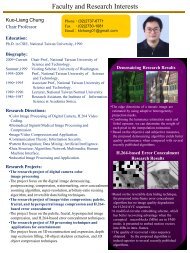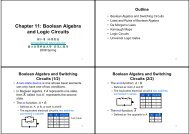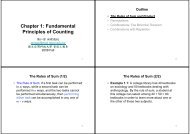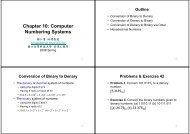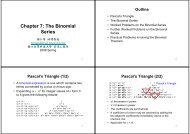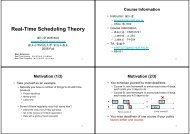Chapter 5: Hyperbolic Functions - 國立台灣科技大學
Chapter 5: Hyperbolic Functions - 國立台灣科技大學
Chapter 5: Hyperbolic Functions - 國立台灣科技大學
Create successful ePaper yourself
Turn your PDF publications into a flip-book with our unique Google optimized e-Paper software.
Outline<strong>Chapter</strong> 5: <strong>Hyperbolic</strong><strong>Functions</strong>謝 仁 偉 助 理 教 授jenwei@mail.ntust.edu.tw國 立 台 灣 科 技 大 學 資 訊 工 程 系2009 Spring• Introduction to <strong>Hyperbolic</strong> <strong>Functions</strong>• Graphs of <strong>Hyperbolic</strong> <strong>Functions</strong>• <strong>Hyperbolic</strong> Identities• Solving Equations Involving <strong>Hyperbolic</strong><strong>Functions</strong>• Series Expansions for cosh x and sinh x12Introduction to <strong>Hyperbolic</strong> <strong>Functions</strong>• <strong>Hyperbolic</strong> sine of x,xe − esinh x = sh x =2− x• <strong>Hyperbolic</strong> cosine of x,ecosh x = ch x =x+ e2− x• <strong>Hyperbolic</strong> cotangent of x,x − x1 e + ecoth x = = tanhx −xx e − e• <strong>Hyperbolic</strong> secant of x,1 2sech x = =xcosh x e + e• <strong>Hyperbolic</strong> tangent of x, • <strong>Hyperbolic</strong> cosecant of x,sinh x1 2tanh x = th x =cosech x = =xcosh xsinh x e − ex −xe − e=x −xe + e−x−x3Some Properties of <strong>Hyperbolic</strong><strong>Functions</strong>• sinh 0 = (e 0 –e –0 )/2 = (1 – 1)/2 = 0• cosh 0 = (e 0 + e –0 )/2 = (1 + 1)/2 = 1• f(x) is an odd function of x if f(–x) = –f(x)– sinh x and tanh x are both odd functions.– As also are cosech x and coth x.• f(x) is an even function of x if f(–x) = f(x)– cosh x and sech x are both even functions.4
Problems• Problem 3. Evaluate, correct to 4 significantfigures, (a) th 0.52 (b) cosech 1.4 (c) sech 0.86(d) coth 0.38[(a) 0.4777 (b) 0.5251 (c) 0.7178 (d) 2.757]Exercise 24Evaluate correct to 4 significant figures.• Exercise 1. (a) sh 0.64 (b) sh 2.182[(a) 0.6846 (b) 4.376]• Exercise 5. (a) sech 0.39 (b) sech 2.367[(a) 0.9285 (b) 0.1859]56Graphs of <strong>Hyperbolic</strong> <strong>Functions</strong> (1/3)Graphs of <strong>Hyperbolic</strong> <strong>Functions</strong> (2/3)108642–3 –2 –1 0 1 2 3–2–4–6y = sinh x108642y = cosh x1–1y = tanh x–3 –2 –1 0 1 2 3–3–2y = coth x–15432–1 0 1–2–3–4–5y = coth x1 2 3–8–10–3 –2 –1 0 1 2 3Since the graph is symmetrical aboutthe origin, tanh x is an odd function.Since the graph is symmetrical aboutthe origin, coth x is an odd function.Since the graph is symmetrical aboutthe origin, sinh x is an odd function.Since the graph is symmetrical aboutthe y-axis, cosh x is an even function.78
Graphs of <strong>Hyperbolic</strong> <strong>Functions</strong> (3/3)1y = sech x–4 –3 –2 –1 0 1 2 3 4321y = cosech xSince the graph is symmetrical aboutthe y-axis, sech x is an even function.–4 –3 –2 –1 0 1 2 3 4–1Since the graph is symmetrical abouty = cosech x –2the origin, cosech x is an odd function.Using Gnuplot to Plot Graphs (1/3)• Gnuplot Homepage: http://www.gnuplot.info/• Command-line driven program for producing 2Dand 3D plots• Mathematical expression accepted by C,FORTRAN, Pascal, or BASIC may be plotted.• Multiplication must be explicit, e.g., 5x aredenoted by 5*x.• Exponents are denoted by **.–3910Using Gnuplot to Plot Graphs (2/3)Supported <strong>Functions</strong>:• Standard trig functions: sin, cos, tan• Inverse trig functions: asin, acos, atan• <strong>Hyperbolic</strong> trig functions: sinh, cosh, tanh• Exponential function (base e): exp• Logarithm functions: log (base e), log10• Absolute value: abs• Square root: sqrtUsing Gnuplot to Plot Graphs (3/3)• 2D: plot – plot x**3• 3D: splot – splot sin(x)+cos(y/5)1112
Exercise 25Prove the given identities.• Exercise 2. (a) coth x ≣ 2cosech 2x + th x(b) ch 2x –1≣ 2sh 2 x2 2• Exercise 4. sh x + ch x −14≡ tanh x2 22chxcothx• Exercise 6. If 5e x –4e –x ≣ A sh x + B ch x, findA and B.[A = 9, B = 1]Solving Equations Involving<strong>Hyperbolic</strong> <strong>Functions</strong>• Change sh x to (e x –e –x )/2 and ch x to (e x + e –x )/2• Rearrange the equation into the form pe x + qe –x +r = 0, where p, q, and r are constants.• Multiply each term by e x , which produces anequation of the form p(e x ) 2 + re x + q = 0• Solve the quadratic equation p(e x ) 2 + re x + q = 0for e x by factorizing or by using the quadraticformula.• Given e x = a constant, take Napierian logarithmsof both side to give x = ln (constant)1718Problems• Problem 12. Solve the equation sh x = 3, correctto 4 significant figures.[1.818]• Problem 14. A chain hangs in the form given byy = 40 ch (x/40). Determine, correct to 4significant figures, (a) the value of y when x is 25and (b) the value of x when y = 54.30.[(a) y = 48.07 (b) x = ±32.89]Exercise 26Solve the equations correct to 4 decimal places.• Exercise 3. 3.5sh x + 2.5ch x = 0[–0.8959]• Exercise 5. 4th x –1 = 0[0.2554]1920
Series Expansions for cosh x and sinh x• By definition,e x = 1 + x + x 2 /2! + x 3 /3! + x 4 /4! + x 5 /5!…• Replacing x by –x gives:e –x = 1 – x + x 2 /2! – x 3 /3! + x 4 /4! – x 5 /5!…• cosh x = (e x + e –x )/2 = 1 + x 2 /2! + x 4 /4! + …• sinh x = (e x –e –x )/2 = x + x 3 /3! + x 5 /5!…Problem and Exercise 27• Problem 17. Determine the power series for2ch(x/2) –sh2x as far as the term in x 5 .[2 – 2x + x 2 /4 – 4x 3 /3 + x 4 /192 – 4x 5 /15 + …]• Exercise 5. Prove the given identity, the seriesbeing taken as far as the term in x 5 only.2 sh (x/2) – ch (x/2) ≣ –1 + x – x 2 /8 + x 3 /24 – x 4 /384+ x 5 /19202122HomeworkAssignment 15, 9, 10, 11, 12Deadline: 5 March 200923


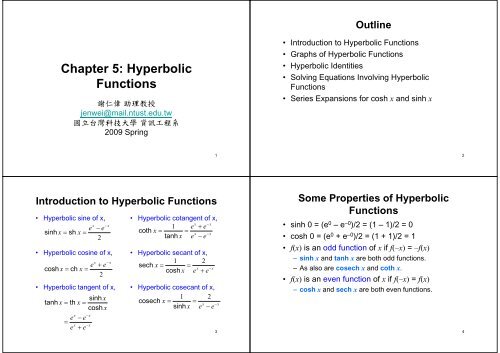
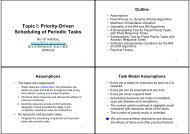

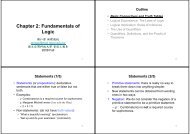

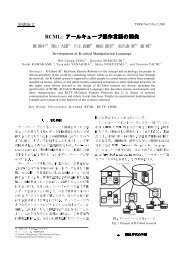
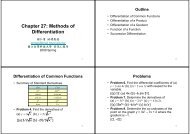
![Lex & Yacc on Cygwin [相容模式]](https://img.yumpu.com/45283703/1/190x134/lex-yacc-on-cygwin-.jpg?quality=85)
